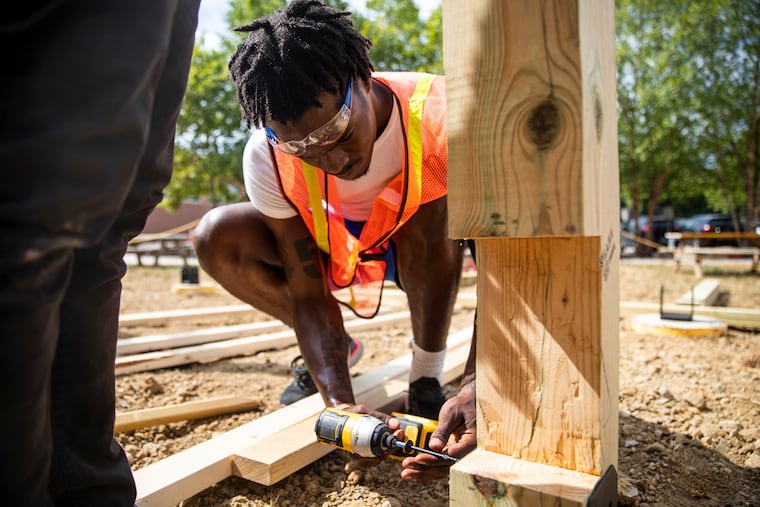Penn partners with West Philly High to give it a new ‘front porch’ and teach students about careers
The project, while giving the school a new space, is aimed at encouraging more students of color to go into architecture and design, disciplines where they have been traditionally underrepresented.

Naasir Davis had never used tools like a power drill or a screwdriver.
Now, the 19-year-old West Philadelphia High School graduate is handy with both, having helped build a new “front porch” for the school, one he had a part in designing.
He’s among 22 teens who participated in a summer program, Design to Thrive, conducted in collaboration with his school and the University of Pennsylvania’s Weitzman School of Design, along with Penn’s Netter Center for Community Partnerships. It’s the latest project in a long-standing partnership between Penn and West Philadelphia, going back as far as 1989, when the high school was still at its old site.
» READ MORE: Black women now lead three of Penn’s prestigious law journals. They talk about what other change they’d like to see.
Students, mostly from West Philadelphia High, under the guidance of Penn graduate students in architecture, landscape, and urban planning, conceived of, designed, and built the outdoor recreational area off Chestnut Street.
The project, while giving the school a new space, is partly aimed at encouraging more students of color to go into architecture and design, disciplines where they have been traditionally underrepresented. Only 2% of architects identified as African American in 2020, the same percentage as a decade earlier, according to the National Organization of Minority Architects. Overall, 22% identified as a racial or ethnic minority.
But the project is expected to achieve more than that, said its manager, Daniel Flinchbaugh, 26, who just graduated from Penn with his master’s in landscape architecture and works for PennPraxis, the applied research arm of Weitzman.
“They’re building self-esteem,” he said. “To see something be in pieces, raw lumber, sitting on the side of the building and then being involved in screwing it, cutting it, putting it up, and designing it, too. That builds a lot of self-esteem.”
It was a summer job, as well. Students earned up to $1,500 for their six weeks of work, which culminated in the unveiling of the space Wednesday to parents and the school community. It includes benches, spruced-up picnic tables, a stage or porch, and an art installation: water bottles filled with a colored resin that will hang like a chandelier and reflect different shades.
Students also designed and installed “protest posts” with messages: “Stop the Gun Violence.” “Sometimes holding on is worse than letting go.” “Respect Our Home.” “Black Lives Matter.”
“Maybe some people will come to school earlier to chill outside a little bit,” said senior Makayla Kidd, 17, as she worked on the water-bottle art piece.
Work will continue throughout the school year, with planters and a garden to be added, as well as a mural. Students will also use the space for science experiments and more. And there are plans to hire a couple of students to take care of the garden.
“The dream would be to keep on going out into that space,” said PennPraxis executive director Ellen Neises, pointing to the large grassy area beyond where students were working.
Over time, the idea would be to inject more of West Philadelphia High’s culture and history into the design, she said.
“We’re giving people a place where they feel welcome and they feel represented,” said P.J. Davis, 20, a Penn senior and architecture major from Upstate New York, who was using an orbital sander on a picnic table. “We are making high school students feel like this is a place that they belong at.”
The project incorporated hands-on lessons in drawing, modeling, and problem-solving. Students also talked about careers in city planning and urban forestry, while trimming trees on the site.
Khalil Williams, a West Philadelphia algebra teacher, said he was thrilled students got to learn about an array of careers, from those requiring college to the trades.
“That’s the biggest takeaway,” he said.
Penn students enjoyed it, too.
“Not having a curriculum set around testing is really freeing,” said Amanda Peña, a Penn graduate student in city planning, who used to teach in a high school in Texas. “Students are really able to show their creativity.”
Justin Brown, 15, a West Philadelphia sophomore, has taken pride in the work.
“I got three more years in this school,” he said. “It will be nice to know if everybody likes it, I was a part of building it.”
He said the work left him at least considering architecture or building as a career, something he hadn’t even known about before.
“Made me think twice,” Kidd agreed.
Davis isn’t interested in pursuing architecture or the building trades. He’s attending East Stroudsburg University in the fall, where he will major in fashion and play basketball. He’d like to have his own clothing line one day, and he also dreams of playing in the NBA or being a coach.
But this summer, he got to try something new. And that was worth it.
“I never thought I’d build a porch and a bench. I never thought I’d do it,” he said. “I love it!”
The Philadelphia Inquirer is one of more than 20 news organizations producing Broke in Philly, a collaborative reporting project on solutions to poverty and the city’s push toward economic justice. See all of our reporting at brokeinphilly.org.